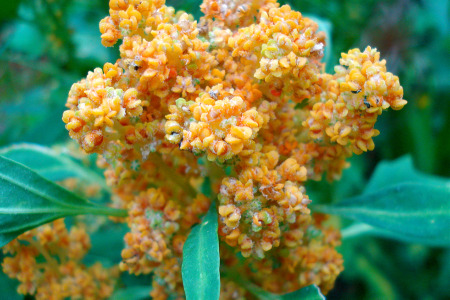Quinoa: The Story of a Cursed Crop
For importers and growers alike, this health food darling has led to nothing but shattered dreams.

Photo by net_efekt/FlickrCC
My Uncle John, a former professor of International Studies at the University of Denver, has the beard of someone who has spent significant time in both academia and Colorado. His mountain home gave me some of my first experiences with an idyllic, Edenic agriculture, which I still dream of whenever I park my car for more than a week. I remember visiting him on a road trip out to Oregon. Before dinner I went out to pick herbs, with grapes winding pleasantly about the fence and small dogs nervously scampering round my feet. Grown farther from his house, Uncle John's purple potatoes are a winter tradition.
The quinoa is a different story.
Uncle John's quinoa farm can be a vexing subject in the family. Fortunes don't fare well on the quinoa fields. After hearing stories of quinoa disaster for years, I called him the other week to ask about it. He called back and left a voicemail: "Incidentally, quinoa is not a past project; it's a present project," he said. "It'sâahâit's a disaster." Uncle John believes that White Mountain Farm is currently the only place growing the Andean grain in the United States for commercial use. Heat, hail, ice, and elk have kept him from a successful crop.
When I began to follow the trail back to the Andes, however, I found that quinoa's troubles began long before Colorado.
Quinoa has a reputation as a miracle foodâambrosia in little crunchy balls. It resembles a grain (though it is not technically a member of the grass family); grows in magnificent, bulky heads; and is the only staple crop that provides a full suite of amino acids. Acre for acre it provides 50 percent more energy than potatoes. The Andean Indians who first cultivated it call it "the mother grain." It has become widely available in the United States and has taken a place in the lexicon of the average American foodie, but that wasn't always the case.
Quinoa traveled a rough road from the Andes across the Rio Grande and into America. Some mystical hand seems to have thrown disaster in its path at every opportunity. The first American importers ran into so much trouble that one of them, Stephen Gorad, only got one satisfactory explanation for his unending quinoa tragedy: to a foreigner stealing food from its native soil, the "mother grain" of the Andes was cursed.
NEXT :
PAGES :
Love hurts.
The early setbacks were practical and expected. Throughout South America, quinoa had a reputation as an Indian food, unsophisticated trash scorned by the middle class in Lima and Quito. As a result, the quinoa economy was ill-equipped for any kind of export, existing in pockets of subsistence farmers who mostly traded among themselves. Gorad traveled to Chilean markets, trying to get what he could. He was able to find a larger grower in Southern Chile who had been sponsored by the Allende government to research quinoa, but not much else. Eventually, some friends of his were able to arrange a 50-pound bag of grain to be shipped to America.
Things seemed to be going well in the late seventies. Gorad met up with Don McKinley, a friend who had studied with Ichazo, and they took their new grain to health-food distributors, doing demonstrations for the managers. They got an overwhelmingly positive response. Of course, they had no idea what to do next.
Years passed before McKinley found a third member of Team Quinoa, an idealistic history Ph.D. from the University of Denver who was the son of a potato farmer. David Cusack was the head of a growing organization called Sierra Blanca in Colorado's San Luis Valley. If import was so hard, they thought, then they could grow the Andean crop in the high altitudes of the Rockies. Together they formed Quinoa Corporation, in 1983.
Gorad was in Chile at the time, and they asked him to ship some quinoa up north. They planted it, but after a year had nothing but weeds. As it turned out, they had grain quinoa, not seed. Quinoa is coated with a bitter substance called saponin, which must be washed off before it can be eaten. But once it has been washed off, it can't be planted.
"Don says 'it didn't work,'" Gorad says. "And I say 'what didn't work?' And he says 'it didn't grow' and I say 'You idiot! You didn't ask me for seed!' This time, I went to get seed. It's not that easy. Actually, doing anything in Chile isn't easy."
Gorad set off to find quinoa—seed quinoa—but he had an even harder time than he did with grain quinoa. One of his contacts finally came through the day before he was scheduled to fly home empty-handed. He brought him a beautiful bag of multi-colored Chilean Altiplano. Gorad looked around, and because he was about to leave he didn't have anything to give this guy in exchange for the quinoa. Exasperated, he fell back on cliché. He bought their first seed with the shirt off his back.
The three members of Quinoa Corp.—McKinley, Cusack, and Gorad—thought it might take around five years to develop a breed of quinoa appropriate to the San Luis Valley. They thought they would be able to prepare the market with imports. The name was a sticking point—the Spanish name was "quinua" with a "u," but they went with the Chilean "quinoa" because it looked nicer.
They offered it to the public for the first time at a health food store in Boulder. People loved it, and it sold as well as they could hope.
They didn't know that the day after, David Cusack would be murdered at a ruin outside La Paz.
PAGES :